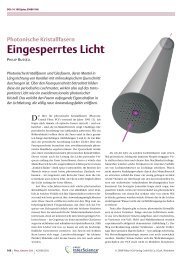Diploma thesis
Diploma thesis
Diploma thesis
Create successful ePaper yourself
Turn your PDF publications into a flip-book with our unique Google optimized e-Paper software.
Material: PPLN<br />
Process : z → z + z<br />
775 nm → 1550 nm + 1550 nm<br />
Λ: 0.35 µm<br />
m: 1<br />
Pump FWHM: 0.21 nm<br />
Dimensions: 4 µm x 4 µm x 5 mm<br />
Table 3.5: Crystal parameters for a counterpropagating setup<br />
Figure 3.44: Pump envelope, phasematching function and joint spectral<br />
amplitude of the counterpropagating process<br />
This is because the phasematching contours are orientated along the signal axis.<br />
Additionally, most of these higher order spatial modes in the suggested waveguide<br />
are unlikely to propagate, and therefore may not be observed at all.<br />
In copropagating PDC the spectral distributions of signal and idler photons are<br />
comparable, as opposed to counterpropagating-PDC where the spectral distribution<br />
of the idler photon is more than one magnitude narrower than that of the signal<br />
photon (see Figures 3.51 and 3.52). Again this is a result of the narrow phasematching<br />
function orientated along the ωs-axis. This narrow spectrum may prove useful.<br />
On one hand, the detector of the heralding photons may be optimized to match the<br />
exact wavelength and hence operate on a high performance level. On the other hand,<br />
this very narrow spectrum is optimal for the propagation through optical fibers, and<br />
may be used to distribute quantum states over large distances.<br />
The phasematching contour along the signal axis may also be used to create<br />
a tuneable pure heralded single photon source. The heralding detector can stay<br />
unchanged while the signal spectrum is changed to an arbitrary wavelength by a<br />
simple tuning of the pump laser central frequency (Figure 3.53).<br />
The feasibility of this photon source depends on the grating periods that can be<br />
manufactured. To date the lowest grating period produced is Λ = 0.8µm in KTP<br />
[25]. Hence, further technology progress is required to produce the needed Λ =<br />
0.35µm. But owing to the importance of nonlinear materials substantial progress<br />
during the next years is expected. One major drawback of counterpropagating PDC<br />
35



